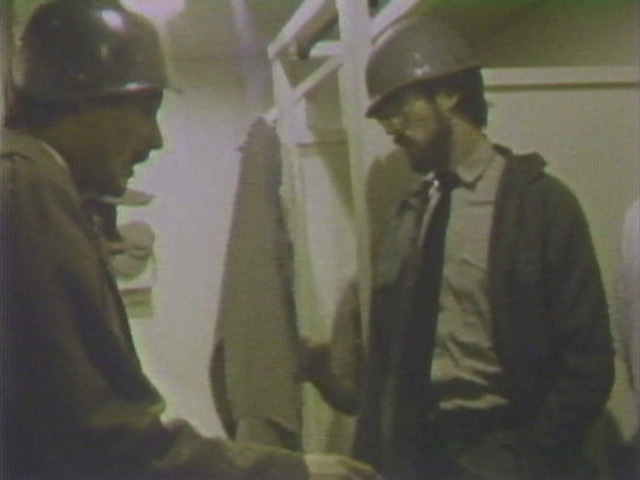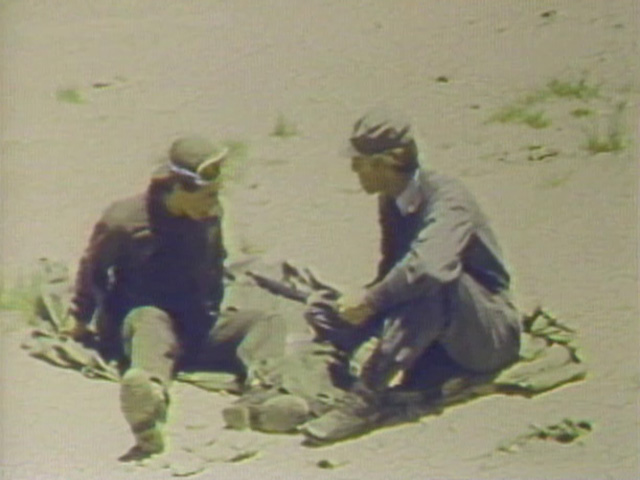Description
"My 1980 production of three hours of material, from which Combat Status Go (as well as the somewhat longer Beholden to Victory and the full-length Hail the Fallen) has been drawn, involved a set of approaches that have been central to the development of all my work in the 1980s. Central to this core of premises has been a conception of the viewer as an active contributor to the performance of a work, a premise that engenders completely new principles for constructing images, scenes, and entire pieces. Combat Status Go has a game, not a story—the game of an Officer and a Private. The Officer may use harsh language, for instance, while the Soldiers have no names. But the rules are for the viewer: as you watch, you see interpretations of the rules, 'played' by real people, with room for the audience to play, too. The 'war film' genre context is a conceit which functions to label the roles as heroic; what reduces heroism to irony is not the nerdiness of the 'heroes,' but the attitude of contempt that is induced within the audience. The idea that a film (videotape) should or could manipulate viewer attitudes in this way is novel and perhaps injudicious. A corresponding problem in literature concerns the unlikeable protagonist, who makes the book unlikeable too. However, the idea here was to open a pathway into a new (and more dignified) culture, in which viewers are aware of efforts to sway their attitudes and respect (in return) opportunities that are afforded for them to control these affinities themselves. But then, what is the relationship between: —the audience and the Soldier? —the audience and the actor? —the director and the actor? —the director and the work? The director must protect his friend the Soldier from the baleful and obscenely intrusive gaze of the ogling Audience. The Audience is an officer corps: they disapprove, as the Officer actors do, of the Soldier(s), the Soldier actors; and in fact, they disapprove of the work itself. It is my duty to my cast (to my work) to be sure that you do disapprove of them; this is the measure of the heroic stature that this tape wants for them—for them, the Soldier, played by many actors, always harassed by their damn Officer, but always yielding and good natured. Combat Status Go is a work designed within an economy of distrusts and of abuses of authority; in particular, the respective abuses of our authoritarian roles as director (on the one hand) and as viewer (on the other). Combat Status Go, Beholden to Victory, and Hail the Fallen are scintillating failures—they transfer the 'Officer' attitude effectively to the audience. The normally ductile viewers (complicitous with the narrative) respond appropriately with contempt for the film (!) on the basis of their disapprobation of the childlike Soldier characters. Some viewers who were actual war veterans, though, reported that the demeaning atmosphere of the film was 'accurate.'" —Tony Conrad
Featuring Patrck Amos, David Antin, Cameron Bishop, D.T. Black, Barbara Broughel, Peter Bull, Wendy Chambers, Tony Conrad, Rob Danielson, Keith Dardick, Leo DeJohn, Randy Erickson, James Fehrman, Bruce Feldman, Louis Hock, Jenny Dietrick, Mike Kelley, Kim Kimball, Howard Kotler, Walter Lab, Standish Lawder, Thomas Mack, Marjorie Nodelman, Sheldon Nodelman, Anne O'Cain, Tony Oursler, Jane Palmer, Charles Rotter, Eriks Rudans, Evan Sakey, Liz Sisco, Judith Spiegel, Kati Tchobanoglos, Susan Wilharm, Elliot Zimmerman, others; Director of Photography - Barbara Broughel; Other cinematography - Tony Conrad, Steve DePaoli, Brian Kantor, Kim Kimball, Standish Lawder, Juliette Mondot; Facilities, Staff Help - Visual Arts Department, Media Center and Distribution Division at UCSD, Media Study at Buffalo


